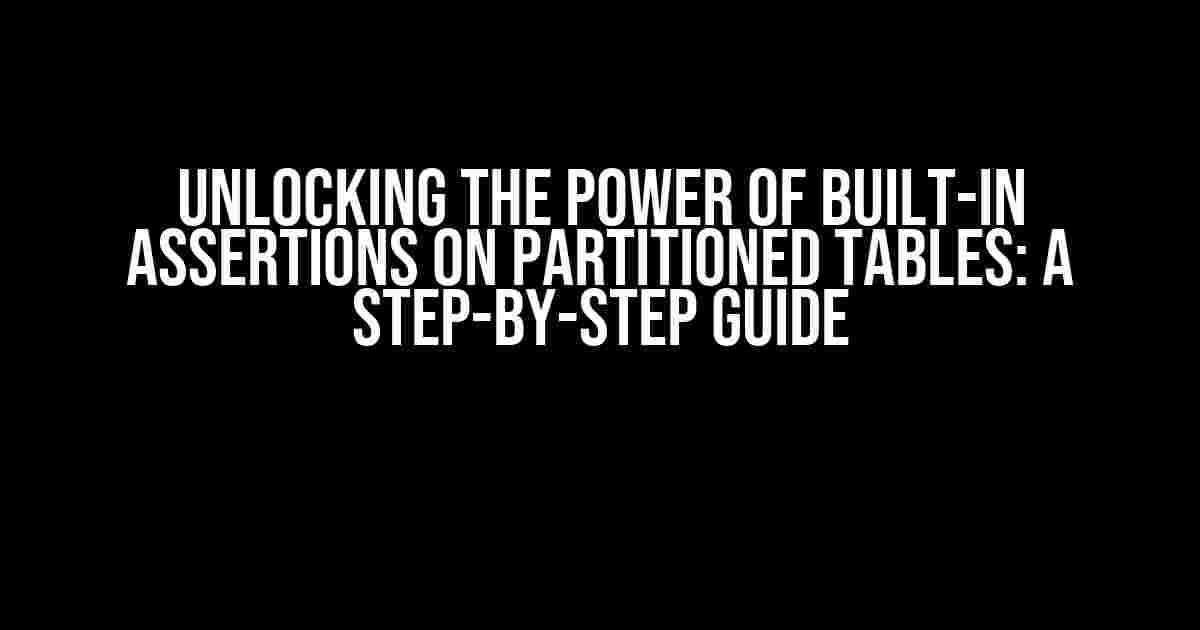Are you tired of manually checking the integrity of your data in partitioned tables? Look no further! In this article, we’ll dive into the world of built-in assertions and show you how to harness their power to ensure data consistency and accuracy. We’ll cover the what, why, and how of using built-in assertions on partitioned tables that require a filter, so buckle up and let’s get started!
What are Built-In Assertions?
Built-in assertions are a feature in database management systems that allow you to define rules to enforce data integrity and consistency. They’re essentially a way to ensure that your data meets certain conditions or criteria, and if it doesn’t, the database will raise an error. In the context of partitioned tables, built-in assertions are especially useful for enforcing data consistency across partitions.
Why Use Built-In Assertions on Partitioned Tables?
Partitioned tables can be a powerful tool for managing large datasets, but they can also introduce additional complexity when it comes to data integrity. By using built-in assertions, you can:
- Ensure data consistency across partitions
- Automatically validate data against a set of rules
- Improve data quality and accuracy
- Reduce the risk of data corruption or inconsistencies
How to Use Built-In Assertions on Partitioned Tables that Require a Filter
Now that we’ve covered the what and why, let’s dive into the how. To use built-in assertions on partitioned tables that require a filter, follow these steps:
Step 1: Create a Partitioned Table
First, you’ll need to create a partitioned table. For this example, let’s create a table called `sales` with three columns: `region`, `product`, and `sales_amount`. We’ll partition the table by `region`.
CREATE TABLE sales ( region VARCHAR(50), product VARCHAR(100), sales_amount DECIMAL(10, 2) ) PARTITION BY RANGE (region);
Step 2: Create Partitions
Next, you’ll need to create partitions for each region. For this example, let’s create three partitions: `north`, `south`, and `east`.
CREATE PARTITION north VALUES LESS THAN ('south');
CREATE PARTITION south VALUES LESS THAN ('east');
CREATE PARTITION east VALUES LESS THAN (MAXVALUE);
Step 3: Create a Built-In Assertion
Now, let’s create a built-in assertion to enforce data consistency across partitions. For this example, let’s create an assertion that ensures the `sales_amount` column is greater than or equal to 0 for all rows in the `north` and `south` partitions.
CREATE ASSERTION sales_amount_check
CHECK (
region IN ('north', 'south') AND sales_amount >= 0
);
Step 4: Filter the Assertion
Since we want the assertion to apply only to the `north` and `south` partitions, we need to add a filter to the assertion. We can do this using the `PARTITION` keyword.
CREATE ASSERTION sales_amount_check PARTITION BY RANGE (region) (PARTITION north, PARTITION south) CHECK ( sales_amount >= 0 );
Step 5: Test the Assertion
Finally, let’s test the assertion by inserting some sample data into the `sales` table.
INSERT INTO sales (region, product, sales_amount)
VALUES ('north', 'Product A', 100.00),
('south', 'Product B', 50.00),
('east', 'Product C', -10.00);
Since the `east` partition doesn’t meet the condition specified in the assertion, the database will raise an error.
ERROR 1048 (23000): The assertion `sales_amount_check` failed.
Benefits of Using Built-In Assertions on Partitioned Tables
By using built-in assertions on partitioned tables, you can:
- Improve data quality and accuracy
- Reduce the risk of data corruption or inconsistencies
- Automatically validate data against a set of rules
- Ensure data consistency across partitions
Best Practices for Using Built-In Assertions on Partitioned Tables
Here are some best practices to keep in mind when using built-in assertions on partitioned tables:
- Define clear and concise rules for your assertions
- Test your assertions thoroughly before deploying them to production
- Regularly review and update your assertions to ensure they remain relevant and effective
- Use filtering to apply assertions to specific partitions or subsets of data
Conclusion
In conclusion, built-in assertions are a powerful tool for ensuring data consistency and accuracy on partitioned tables. By following the steps outlined in this article, you can create effective assertions that meet your specific needs and requirements. Remember to test and review your assertions regularly, and don’t hesitate to reach out if you have any questions or need further guidance.
| Keyword | Definition |
|---|---|
| Built-in assertion | A feature in database management systems that allows you to define rules to enforce data integrity and consistency. |
| Partitioned table | A table divided into smaller, more manageable pieces, or partitions, to improve performance and scalability. |
| Filter | A condition or set of conditions that determines which data is affected by an assertion. |
By mastering the art of using built-in assertions on partitioned tables, you’ll be able to take your data management skills to the next level and ensure the integrity and accuracy of your data.
- Define clear and concise rules for your assertions
- Test your assertions thoroughly before deploying them to production
- Regularly review and update your assertions to ensure they remain relevant and effective
- Use filtering to apply assertions to specific partitions or subsets of data
So, what are you waiting for? Start harnessing the power of built-in assertions on partitioned tables today and take the first step towards data integrity and accuracy!
Here is the requested FAQ page about using built-in assertions on partitioned tables that require a filter:
Frequently Asked Question
Get the answers to your burning questions about using built-in assertions on partitioned tables that require a filter!
Can I use built-in assertions on a partitioned table without specifying a filter?
No, when using built-in assertions on a partitioned table, you must specify a filter to define which partition(s) the assertion applies to. This ensures that the assertion is only applied to the relevant data.
How do I specify a filter when using built-in assertions on a partitioned table?
You can specify a filter using the PARTITION BY clause, followed by the column(s) that define the partition(s) you want to apply the assertion to. For example, `PARTITION BY (column1, column2) WHERE column1 = ‘value1’ AND column2 = ‘value2’`.
Can I use multiple filters when using built-in assertions on a partitioned table?
Yes, you can use multiple filters by specifying multiple conditions in the WHERE clause, separated by AND or OR operators. For example, `PARTITION BY (column1, column2) WHERE column1 = ‘value1’ AND (column2 = ‘value2’ OR column3 = ‘value3’)`.
What happens if I don’t specify a filter when using built-in assertions on a partitioned table?
If you don’t specify a filter, the assertion will be applied to the entire partitioned table, which may lead to unexpected results or errors. It’s essential to specify a filter to ensure the assertion is applied only to the relevant partition(s).
Can I use built-in assertions on a partitioned table with multiple partitions?
Yes, you can use built-in assertions on a partitioned table with multiple partitions. Simply specify the partition(s) you want to apply the assertion to using the PARTITION BY clause and filter conditions. The assertion will be applied to each specified partition individually.
I hope this helps! Let me know if you need anything else.



